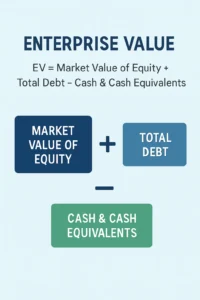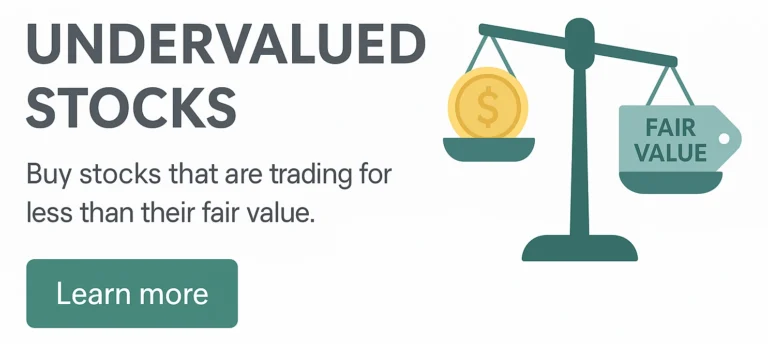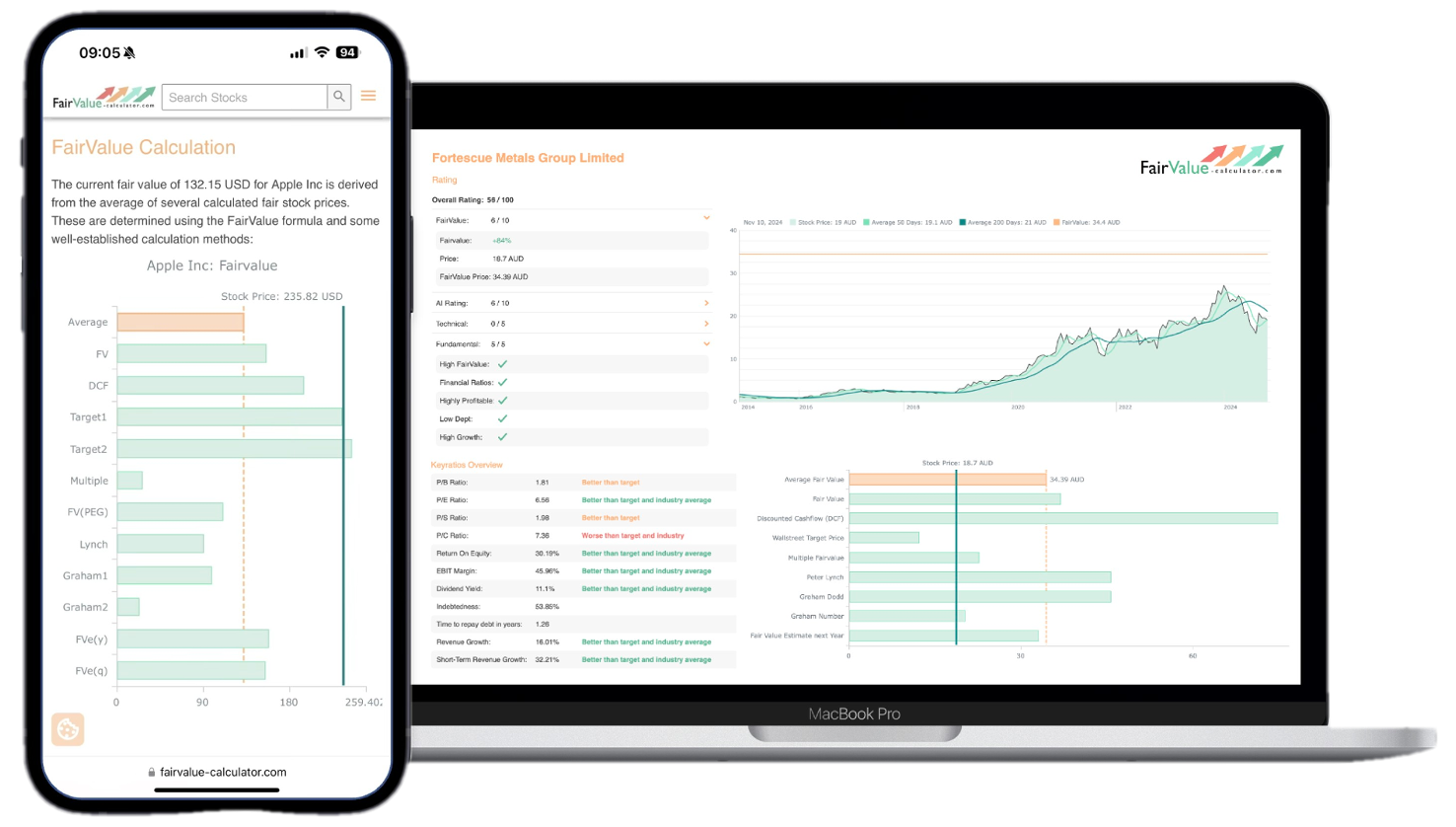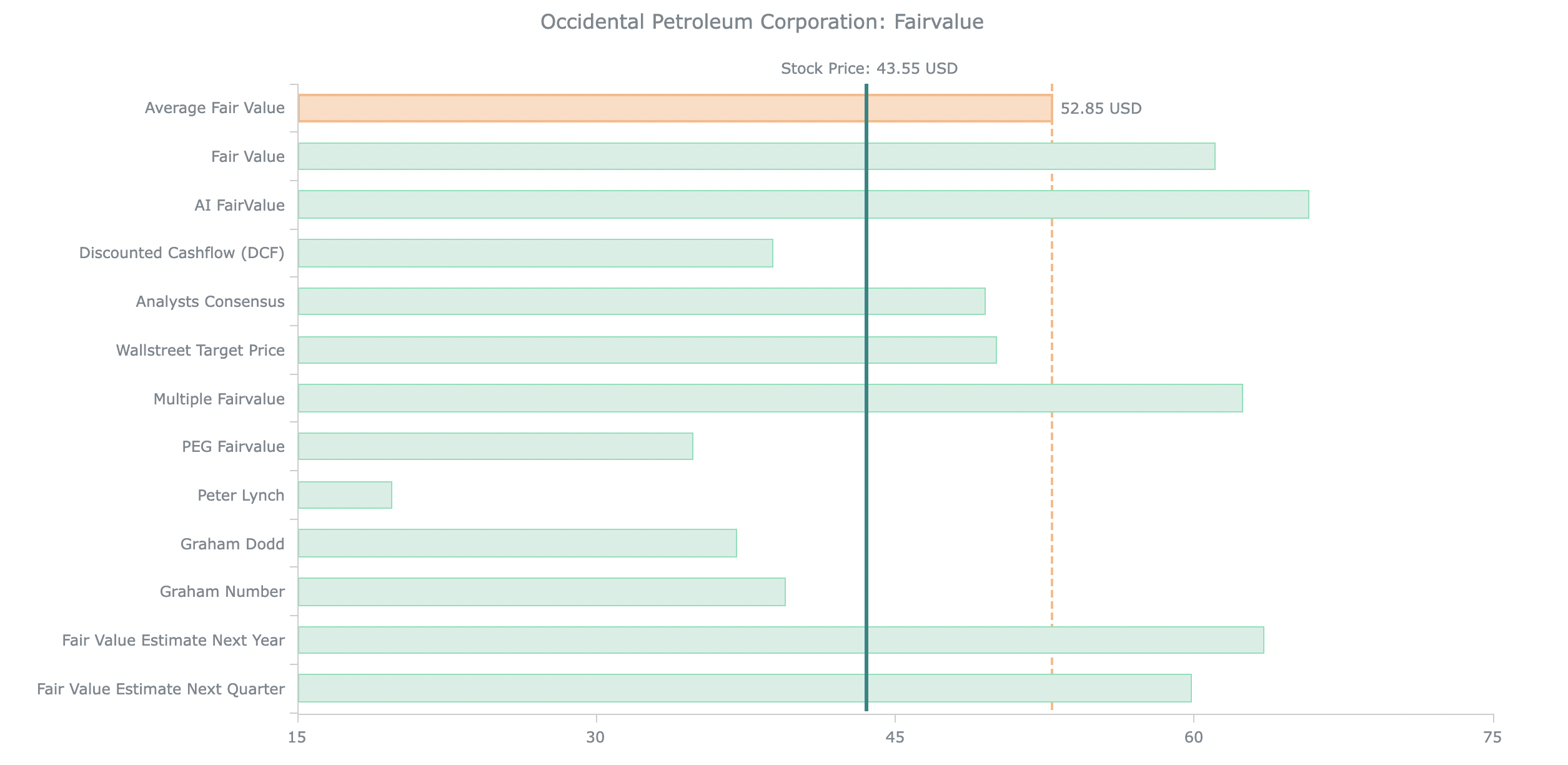Enterprise Value Calculator
What is a company truly worth? The Enterprise Value reveals the total value, including debt and cash.
Enterprise Value Calculator
Calculate a company's true value by considering debt and cash. Enter the values below and click calculate.
Get Even More Value!
- Instantly discover the Peter Lynch Fair Value for over 45,000 stocks – fully automated, zero effort.
- The Pro Tool for serious investors: Automated stock analysis using 10+ valuation models, including the Peter Lynch Fair Value.
- A powerful algorithm combines AI and over ten valuation models to calculate an average Fair Value – based on DCF, Buffett, Graham, PEG ratio, Peter Lynch, multiples, P/B, P/S and more!
How to Calculate the Enterprise Value:
To calculate a company’s Enterprise Value (EV) you need three inputs: market capitalization, total debt, and cash & equivalents. Market capitalization is the share price multiplied by the number of shares outstanding — you’ll find it on portals like Yahoo Finance, MarketScreener, or directly on the company’s Investor Relations page. Total debt (often shown as “Total Debt” or “Short‑Term Debt + Long‑Term Debt”) is listed on the balance sheet; you can pull it from MarketScreener, TIKR, or the company’s annual report. Cash & equivalents (sometimes “Cash and Short-Term Investments”) is also on the balance sheet and can be found on sites like Morningstar or Yahoo Finance.
Once you have the three figures, plug them into the formula:
Enterprise Value = Market Capitalization + Total Debt − Cash & Equivalents
Enter the numbers in the calculator and you’ll instantly see the EV — a truer picture of what the whole business is worth when you account for how it’s financed. This metric is especially helpful for comparing companies with very different leverage levels and for ratios like EV/EBITDA.
Prefer zero manual data hunting? In our Premium Tool, all required fundamentals for 45,000+ stocks are loaded automatically and processed further to deliver Enterprise Value, Fair Values from 10+ valuation models (DCF, Graham, Peter Lynch, Buffett, PEG, multiples, and more) — instantly, no spreadsheets needed.
What Is the Enterprise Value?

The Enterprise Value (EV) represents the true value of a company — beyond just its stock price. Unlike market capitalization, which only considers equity, the EV accounts for debt and cash as well. This makes it a more accurate measure of what it would cost to acquire the entire business.
In simple terms:
Enterprise Value = Market Cap + Debt − Cash
It answers the question: “What would I really pay if I wanted to buy the whole company?”
For example, a company with a $5B market cap, $2B in debt, and $1B in cash has an EV of $6B — not $5B.
EV is widely used in valuation ratios like EV/EBITDA, which are more meaningful than simple P/E ratios, especially when comparing companies with different capital structures. It’s a core metric for institutional investors and analysts.
Want to go deeper without doing the math yourself?
Try our Premium Tool – it calculates the Enterprise Value automatically and combines it with over 10 valuation models to show you what a stock is really worth. Fast, accurate, and tailored for value investors.
Top 10 Stocks: High Market Cap Strategy
This list is updated daily by our Stock Screener Tool, covering more than 60,000 stocks worldwide. Discover this and many other Top-Lists inside the Fairvalue Calculator Premium Tool – try it now for free!
What Is the Enterprise Value Formula?
Enterprise Value (EV) Formula
The Enterprise Value (EV) represents the total value of a company — including debt and excluding cash. It reflects what it would actually cost to acquire the entire business.
This formula is widely used by analysts and investors to assess the true worth of a company beyond its share price. For example, if a company has a market cap of $5B, $2B in debt, and $1B in cash, the EV is $6B.
You can calculate EV instantly with our automated valuation tools. Try our Premium Access for full insights and fair value estimates on thousands of stocks.
FAQ: Enterprise Value (EV) Calculator
Build a clean Enterprise Value for fair EV/EBIT(DA) comparisons and DCF work. Keep book vs market and periods consistent.
What is Enterprise Value in one line?▾
Which formula does this page use?▾
EV = Market cap (+ preferred equity) + Total debt (+ lease liabilities) + Minority interest − Cash & cash equivalents (and other non-operating, surplus cash).Use market values where relevant and match the same date for all inputs.
What do I type into each field?▾
- Market cap: price × diluted shares (same date as debts/cash).
- Total debt: short + long-term interest-bearing debt; include lease liabilities if you will compare EV/EBIT or EV/EBITDA consistently.
- Cash & equivalents: cash, ST investments; exclude restricted cash.
- Minority interest (NCI): equity attributable to non-controlling interests.
- Preferred equity (if any): add at market or redemption value.
How do I handle leases (IFRS 16/ASC 842)?▾
What counts as cash to subtract?▾
How is EV different from equity value (market cap)?▾
How should I use EV after I calculate it?▾
- Compare EV/EBIT or EV/EBITDA with peers on Stock Valuation.
- Use EV with FCFF in a DCF (discount at WACC).
- Ensure capital structure (leases, pensions) is treated the same in EV and in the multiples/DCF.
Common mistakes to avoid▾
- Mixing book values for debt with market equity on different dates.
- Omitting minority interest while using consolidated EBIT/EBITDA.
- Double-counting leases or subtracting restricted cash.
- Comparing P/E (equity metric) to EV-based earnings—don’t mix frameworks.
Quick checklist for a “clean” EV▾
- Same date and currency for all inputs.
- Debt = ST + LT + leases (if chosen) at carrying value; reconcile to notes.
- Subtract only available cash and ST investments.
- Add NCI and preferred if present; document any non-operating adjustments.





